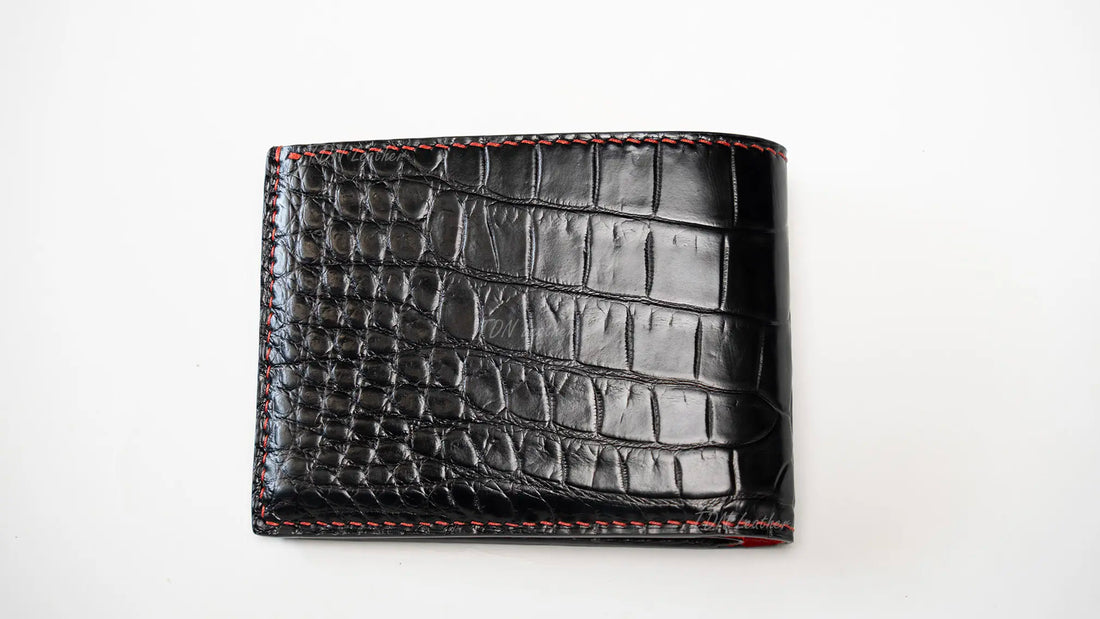
Wallets for Men: A Simple Guide to Styles, Materials, and What Actually Works Day to Day
Share
If you haven’t thought much about your wallet since college, you’re not alone. The right wallet just disappears into your life—until it doesn’t. This guide breaks down the main wallet styles for men, the real‑world pros and cons of each, and the leathers that make the biggest difference in hand.
The main wallet styles (and who they’re for)
Bifold (horizontal)
-Why people choose it: The classic. Fast access to bills and your most‑used cards; easy to live with every day.
-Watch‑outs: Can get bulky if you overstuff it. Slim designs keep layers down and feel better in a front pocket. Carryology sums it up well: a good bifold balances storage and access, but too many layers = pocket bulge. 
Vertical bifold
-Why people choose it: Same idea as a bifold, just taller and narrower. Slides neatly into a front pocket or a jacket’s inner pocket with cards stacked vertically.
-Watch‑outs: If you carry lots of receipts or coins, it fills up fast.
Long / coat / breast‑pocket wallet
-Why people choose it: Keeps banknotes flat (no folding), ideal for suit or overcoat breast pockets and travel documents. Also called a “secretary wallet.”
-Watch‑outs: Not great in jeans; it’s built for jackets and dress wear.
Card holder (slim card case)
-Why people choose it: Minimal, front‑pocket friendly, great if you mostly tap your phone and carry just a few cards.
-Watch‑outs: Limited capacity; cash has to be folded or tucked in a slip pocket. (Minimalist EDC trends have pushed more people toward small card carriers.) 
Money clip (with or without a few card slots)
-Why people choose it: Ultra slim; cash stays accessible.
-Watch‑outs: Best if you carry mostly cash or very few cards; otherwise you’ll outgrow it quickly. (Most minimalist clips hold just a handful of cards.)
Trifold
-Why people choose it: More panels = more compartments for lots of cards/IDs.
-Watch‑outs: Extra folds add thickness. If you’re chasing a slim front‑pocket carry, a trifold makes that harder.
Zip wallet / coin wallet
-Why people choose it: Keeps coins, keys, SIMs and receipts under control; great for travel.
-Watch‑outs: Zippers add structure (and a little bulk).
Quick pick: If you live in a blazer, try a long/breast wallet. If you live in tees and denim, a slim bifold or card holder is the easiest win.
The leather you choose changes everything
Different leathers don’t just look different—they feel different in hand and age differently. Here’s how the popular options stack up, in practical terms.
Cowhide (especially vegetable‑tanned cowhide)
-What it feels like: Starts firm and structured, softens with use; develops a rich patina (darkening and sheen) that tells the story of how you carry it. Makers love veg‑tan cowhide for exactly that patina. Weaver Leather Supply
-Day‑to‑day reality: Veg‑tanned leather is more sensitive to water than chrome‑tanned leather; it can discolor or stiffen if soaked and dried. Chrome‑tanned cowhide is typically softer and more water‑stable out of the box.
-Best for: People who enjoy character—the way a wallet ages to a deeper, glossier tone over the years.
-Nice example: If patina is your thing, this men’s veg‑tanned cowhide wallet (hand‑dyed, hand‑stitched) shows off that classic veg‑tan look beautifully.
Crocodile leather
-What it feels like: Distinct, architectural scale pattern; a polished, dressy presence with surprising suppleness when tanned well.
-Day‑to‑day reality: It’s an exotic leather associated with luxury houses and makes up a tiny fraction of global leather use (part of why it’s rare and pricey). Quality hides are farmed and tanned under strict controls.
-Best for: Dress wallets and statement pieces you’ll carry for years.
-Compliance note: When buying or traveling internationally with exotics, look for CITES compliance; in the U.S., the Fish & Wildlife Service manages permitting for CITES‑listed species. U.S. Fish and Wildlife Service+1
-Nice example: For a refined take with scaled texture, explore this men’s handmade crocodile leather wallet.
Lizard leather (e.g., ring/Java lizard, Teju)
-What it feels like: Finer, tighter scale pattern than croc or gator; thin yet surprisingly robust—ideal for small leather goods like wallets and watch straps.
-Day‑to‑day reality: Because it’s thin and crisp, it makes slim, elegant wallets that still hold their shape.
-Best for: Minimalist dress wallets and card holders where you want texture without bulk.
-Nice example: Prefer that fine‑grain look? See this men’s handmade lizard leather wallet—compact and sharp.
Ostrich leather
-What it feels like: Soft, supple, immediately luxurious—with the signature quill follicle “polka‑dot” texture. Many enthusiasts love the tactile feel.
-Day‑to‑day reality: Ostrich is considered very strong for its weight, and its natural oils help it resist drying and cracking over time—one reason it’s prized for long‑wearing accessories.
-Best for: A statement wallet that’s as comfortable as it is durable; excellent if you want a leather that stays supple for years.
Matching style + leather to your actual carry
-“I carry 4–6 cards and tap to pay most days.”
Go card holder in veg‑tanned cowhide if you love patina, or lizard if you want slim structure with a refined texture. (A lizard card case keeps a tailored silhouette.)
-“I still use cash and need something that disappears in jeans.”
A slim bifold in veg‑tanned cowhide balances cash access with a thin profile—and it only gets better looking as it ages. Weaver Leather Supply
-“I wear a blazer at work and want something elevated.”
A long/breast‑pocket wallet in crocodile is the classic “dress wallet” play—notes stay flat, and the scaled leather reads formal.
-“I travel a lot and juggle coins, tickets, and receipts.”
A zip wallet in durable cowhide keeps small items from escaping and organizes different currencies.
Bottom line: Pick the format that fits your pockets and habits, then choose the leather whose feel and aging you’ll enjoy. When you get those two decisions right, your wallet quietly does its job—and looks better every month you carry it.
